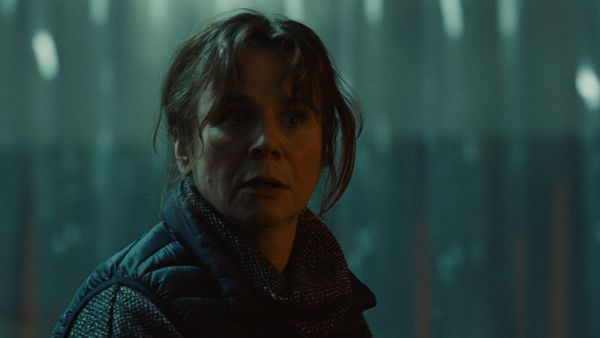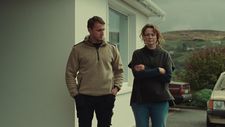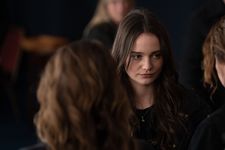 |
| Emily Watson in God's Creatures Photo: A24 |
Directed by Saela Davis and Anna Rose Holmer, and written by Shane Crowley from an idea he co-wrote with the film’s producer, Fodhla Cronin O'Reilly, God’s Creatures centres on the fallout from an accusation. Shortly after her estranged son Brian O’Hara (Paul Mescal) returns home from Australia, Aileen (Emily Watson) is forced to choose between her moral sense of duty and protecting her only son, when Sarah (Aisling Franciosi), who she supervises at the seafood processing factory, accuses him of rape. Eileen chooses to lie to the police, and then her family begins to slowly unravel. Meanwhile, Sarah withdraws and is shunned by the tight knit community.
In conversation with Eye For Film, Davis and Holmer discussed building the mechanics of their story around breathing rhythms and replacing words with images. They also spoke about exploring oppressive structures that trap men and women alike, and how their film is a ghost story lurking beneath the surface of a psychological drama.
Paul Risker: Why film as a means of creative expression? Was there an inspirational or defining moment?
Saela Davis: It wasn't straightforward – it started when I was younger. I was into reading and I loved stories, and so as I got older my obsession with storytelling grew. I didn't understand or connect that to a career path until I was in high school - the time you're taught to start thinking about what you're going to do in adulthood.
 |
| Mother and son Photo: A24 |
I was looking at art schools and I wanted to pursue writing. I lived in New Jersey at the time and NYU was a prospect. When I discovered their filmmaking programme, I think a lightbulb just went off: ‘Oh, there's this other way to tell stories.’
I loved films when I was younger, and I’d watch classic cinema with my dad. I don't know if I was serious about it [filmmaking] at the time, and so directing as a pursuit came to me through film school. I was watching classic films, and the French New Wave particularly jumped out at me, in that it was an exciting form, and the way in which those filmmakers were breaking rules excited and stimulated something in me. This locked in the certainty that filmmaking is the path for me.
Anna Rose Holmer: … I came to film through photography, specifically through the technical craft of image making. Early on my desire was to be a cinematographer. I’d begun working as a loader and a focus puller, and repairing 16mm cameras. I was a camera assistant on the photographic side, working dark rooms, and I came to film school with that technical background. The physical process of making images was, and still is, so compelling to me.
What I fell in love with about filmmaking was its collaborative nature, that it required many voices, many hands. Some people may say it's not an art form, it's a business, but on the art side it's an incredibly resource-heavy art form. It requires a lot of capital, it requires a lot of people, and even if you're doing it on a low budget, you cannot do it alone.
The epic task that is making a feature film, and the impossibility of pulling it off, is something we're all a little bit addicted to.
PR: There’s a musical dimension to cinema, but not as it pertains to the soundtrack, and the diegetic and non-diegetic sound – it’s a rhythm you feel. I love coming to a film and getting that sense of rhythm: What’s the first image? What’s the pace of the edit? The relationship between the narrative and aesthetic also plays a part in creating a rhythmic flow in God’s Creatures.
ARH: The way we talk about it is breath and that starts with the script - examining those rhythms. What is the rhythm you're establishing and when do you break it? When are you exhaling? When are you gasping? When are you holding your breath? We think about that in terms of story mechanics and then all the things we're adding onto it, the edit points, the score, holding onto a shot, all of these punctuations are building this living thing that's breathing and has emotions. It's this ecosystem, it's not pinpointing one exact tool, but what's the alchemy or the dance between these elements?
This film in particular, structurally and narratively, was something that we worked alongside our screenwriter Shane Crowley, and our creative producer Fodhla Cronin O'Reilly, developing the script for two and a half years. Much of that was about upending and challenging those norms and expectations about what a story like this might look like onscreen.
SD: To the point of what the story should look like, throughout the whole process we were pushing back against the common tropes. We didn't want this to be procedural, we wanted it to be more of a psychological experience, and our ethos throughout was be bold. Anna and I always reminded each other of that, and again, referencing the French New Wave, it was that desire to make something different, not just for the sake of something different, but to express our artistic ideas.
How do you do that? What would that look like? It was constantly evolving once we were in the edit, where it was thinking about how images will convey something instead of the dialogue – a picture versus a thousand words to be cliché. Thinking about that, we were constantly honing in on that idea and how we could make this bolder. It was exciting to play in that space to find the film, with all of those other layers, the sound and music, and the images.
 |
| Sarah is alone in a crowd Photo: A24 |
ARH: You just reminded me how that ethos to be bold came to be expressed. With our collaborators, we're not retelling a series of facts, we're making a poem about that experience. This isn't about events that unfold, this is about the reflection of those events, and the ramifications in the bodies and minds of this community. So in that choice of looking away from the event, looking on the faces [of the characters] as they listen, it was often about the choice of what is offscreen, where what we're choosing to not show is just as important as what we're showing. In terms of the economy of image, which means many things, but also with sound, we were looking for the poetry. We trusted that our audience was here to go on that type of journey.
PR: It's not until the halfway mark that the main thrust of the plot begins with the accusation. It seems things are taking place in the narrative's own dark shadows, and the crime slithers out of the darkness. The film is not strictly interested in guilt or innocence, but the messiness of human nature and relationships. You offer the audience a sensory, as much as a narrative and psychological, experience, and trust they’ll be active participants in understanding the characters and the events.
SD: Our intention with our opening frames was that it's like you don't know where you are and what’s happening – it’s disorientating. We pull above the surface and it's calm and still. The water is obviously a motif throughout the film and we're always pointing to that idea of what lies beneath – the most obvious reflection is Brian. He returns, he is the thing that Eileen has been waiting for, the love of her life, the apple of her eye. Then that slowly deteriorates over time and she sees into the dark waters.
When we went to Ireland on our scouting, there's this beauty juxtaposed with a darkness, but not in the environment. The waves are beautiful to look at, but they can take your life. Conceptually, that was something we were thinking about throughout the process of making this film.
ARH: One of the things we talked a lot about with Chayse Irvin, our cinematographer, and Inbal Weinberg, our production designer, is that we think of the film as a spiral. You return to a lot of familiar images, but from a different vantage point. We're creating a language and then breaking it, or putting you in a new perspective. How do you have that evolving language that feels familiar and new at the same time? There are some of those things with Brian.
You talk about the shadows – often, what we wanted to do with Chayse was have the pool of light that would illuminate Brian, but place him outside of it. The corner scene with [the pub landlord] Dan Nell for example, whose face is catching the light, but when we come around to Brian, we find that he is in silhouette - he's outside of that light.
It's not always about the environment. Dan Nell’s looks like that throughout, but where we're placing the bodies is changing and evolving. It's about setting up these tools that have been there the whole time, but if you look at it from this vantage point, all of a sudden it looks different. It was exciting to build that into the world from the first frame, because we're looking at Brian through Eileen's eyes – it’s her perspective and it’s changing over the course of the film.
SD: We have a similar approach with the sound design and music. In the beginning of the film you observe the environment, the space they exist in as normal - water, the oyster shells, the wind. Slowly, over time, those elements in the sound design are repurposed and fused with the score. You don't quite notice it, but the way the oyster shells clack is a little different, and they’re part of the score. So again, it's used to reflect Eileen's psychological space and its evolution.
PR: A theme I take from the film is the toxicity of the maternal, and how Eileen’s love for her son is destructive to her family, as well as her own sense of self.
ARH: This toxicity which you're pointing to is not inherent or ingrained, mothering or loving, in any capacity. That's not what we're saying. The toxicity comes from valuing mothers, especially, on their output to society, and often times, that currency is sons. Eileen’s identity becomes entwined to the point where she can not distinguish when a moral judgement on her son becomes a moral judgement on her. It isn't about the maternal, but about how the society defines and limits the maternal.
 |
| Watching the waves Photo: A24 |
In our film, Eileen has a very different relationship with her daughter Erin, one that's open, that allows for honesty and vulnerability, and an exchange of minds as equals. Eileen is able to pass on healthy traditions to her grandson - she teaches him Irish. So it's not mothering that we're examining, but the role that society plays in limiting mothering.
SD: Another way to put it is, where does that toxicity stem from? I think it stems from this society and the environment. Eileen is a product of her environment, and it exists in many small communities across the world. We’re looking at a specific character in a specific place, who is a product of her environment. But then she looks at that environment and asks what are the traditions worth holding onto, and what are the traditions worth breaking?
Erin is a version of that. She's a woman who is choosing to break those traditions in order to raise her son in a new world. She has hope that change is possible, but Sarah takes a different path. She chooses to leave, but she still carries the traditions she values with her.
To reiterate, Eileen is a product of a very specific environment and it's on her to make new choices. What is commendable is at that age, she makes new choices and that's a huge step for her, and hopefully it's impactful for other people to witness.
ARH: No one escapes this poison, whatever the source is. The men in this community are beholden and haunted by and affected by the same structures that oppress the women. It reflects in a different way, but this is something that's all encompassing in our society.
PR: While God’s Creatures is not a traditional horror film, like the swells beneath the surface of the water, a horror gradually penetrates the psychological drama.
ARH: On the horror side, we talk about this as a making of a ghost film. Eileen and Sarah are going to be haunted by the same ghosts for the rest of their lives. Healing and surviving doesn't end when the credits roll. We were building this horror motif into the film, and it's only through Sarah's articulation of it at the end, that these ghosts everybody has been hearing come into focus.
For us, that invisible haunting, that sense of dread is the experience of the women in the community. They hear, respond and recognise this invisible fabric all around them. How do you build that experience so that the audience can relate to it by the time Sarah says she has heard it, felt it, that she recognises it’s there and it has been her experience? To render that real, to have that be a sensory experience that the audience can relate to, helped us build in empathy, understanding and a connection with Sarah at that point. For us, the truth of a place is the ghosts that it carries and cinema allows you to play with rendering those invisible possibilities, so that everyone can experience them.
God’s Creatures played at the Glasgow Film Festival 2023, followed by a theatrical release from Volta Pictures in Ireland and Northern Ireland on 24 March 2023, and in the rest of the UK on 31 March 2023 via the BFI. The film was released theatrically in the US by A24 on 30 September 2022.





















